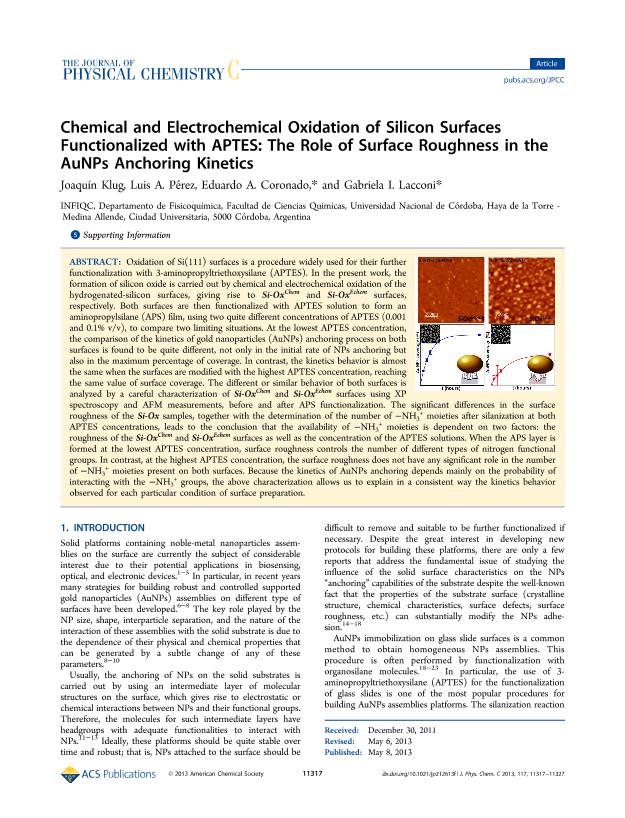Mostrar el registro sencillo del ítem
dc.contributor.author
Klug, Joaquín

dc.contributor.author
Pérez, Luis Alberto

dc.contributor.author
Coronado, Eduardo A.

dc.contributor.author
Lacconi, Gabriela Ines

dc.date.available
2017-09-29T16:45:01Z
dc.date.issued
2013-05
dc.identifier.citation
Klug, Joaquín; Pérez, Luis Alberto; Coronado, Eduardo A.; Lacconi, Gabriela Ines; Chemical and electrochemical oxidation of silicon surfaces functionalized with APTES: the role of surface roughness in the AuNPs anchoring kinetics; American Chemical Society; Journal of Physical Chemistry C; 117; 21; 5-2013; 11317-11327
dc.identifier.issn
1932-7447
dc.identifier.uri
http://hdl.handle.net/11336/25429
dc.description.abstract
Oxidation of Si(111) surfaces is a procedure widely used for their further functionalization with 3-aminopropyltriethoxysilane (APTES). In the present work, the formation of silicon oxide is carried out by chemical and electrochemical oxidation of the hydrogenated-silicon surfaces, giving rise to Si-OxChem and Si-OxEchem surfaces, respectively. Both surfaces are then functionalized with APTES solution to form an aminopropylsilane (APS) film, using two quite different concentrations of APTES (0.001 and 0.1% v/v), to compare two limiting situations. At the lowest APTES concentration, the comparison of the kinetics of gold nanoparticles (AuNPs) anchoring process on both surfaces is found to be quite different, not only in the initial rate of NPs anchoring but also in the maximum percentage of coverage. In contrast, the kinetics behavior is almost the same when the surfaces are modified with the highest APTES concentration, reaching the same value of surface coverage. The different or similar behavior of both surfaces is analyzed by a careful characterization of Si-OxChem and Si-OxEchem surfaces using XP spectroscopy and AFM measurements, before and after APS functionalization. The significant differences in the surface roughness of the Si-Ox samples, together with the determination of the number of −NH3 + moieties after silanization at both APTES concentrations, leads to the conclusion that the availability of −NH3 + moieties is dependent on two factors: the roughness of the Si-OxChem and Si-OxEchem surfaces as well as the concentration of the APTES solutions. When the APS layer is formed at the lowest APTES concentration, surface roughness controls the number of different types of nitrogen functional groups. In contrast, at the highest APTES concentration, the surface roughness does not have any significant role in the number of −NH3 + moieties present on both surfaces. Because the kinetics of AuNPs anchoring depends mainly on the probability of interacting with the −NH3 + groups, the above characterization allows us to explain in a consistent way the kinetics behavior observed for each particular condition of surface preparation.
dc.format
application/pdf
dc.language.iso
eng
dc.publisher
American Chemical Society

dc.rights
info:eu-repo/semantics/openAccess
dc.rights.uri
https://creativecommons.org/licenses/by-nc-sa/2.5/ar/
dc.subject
Silicon Surfaces
dc.subject
Surface Functionalization
dc.subject
Gold Nanoparticles
dc.subject
Kinetics Processes
dc.subject.classification
Otras Ciencias Químicas

dc.subject.classification
Ciencias Químicas

dc.subject.classification
CIENCIAS NATURALES Y EXACTAS

dc.title
Chemical and electrochemical oxidation of silicon surfaces functionalized with APTES: the role of surface roughness in the AuNPs anchoring kinetics
dc.type
info:eu-repo/semantics/article
dc.type
info:ar-repo/semantics/artículo
dc.type
info:eu-repo/semantics/publishedVersion
dc.date.updated
2017-09-28T19:04:08Z
dc.journal.volume
117
dc.journal.number
21
dc.journal.pagination
11317-11327
dc.journal.pais
Estados Unidos

dc.journal.ciudad
Washington DC
dc.description.fil
Fil: Klug, Joaquín. Consejo Nacional de Investigaciones Científicas y Técnicas. Centro Científico Tecnológico Conicet - Córdoba. Instituto de Investigaciones en Físico-química de Córdoba. Universidad Nacional de Córdoba. Facultad de Ciencias Químicas. Instituto de Investigaciones en Físico-química de Córdoba; Argentina
dc.description.fil
Fil: Pérez, Luis Alberto. Consejo Nacional de Investigaciones Científicas y Técnicas. Centro Científico Tecnológico Conicet - Córdoba. Instituto de Investigaciones en Físico-química de Córdoba. Universidad Nacional de Córdoba. Facultad de Ciencias Químicas. Instituto de Investigaciones en Físico-química de Córdoba; Argentina
dc.description.fil
Fil: Coronado, Eduardo A.. Consejo Nacional de Investigaciones Científicas y Técnicas. Centro Científico Tecnológico Conicet - Córdoba. Instituto de Investigaciones en Físico-química de Córdoba. Universidad Nacional de Córdoba. Facultad de Ciencias Químicas. Instituto de Investigaciones en Físico-química de Córdoba; Argentina
dc.description.fil
Fil: Lacconi, Gabriela Ines. Consejo Nacional de Investigaciones Científicas y Técnicas. Centro Científico Tecnológico Conicet - Córdoba. Instituto de Investigaciones en Físico-química de Córdoba. Universidad Nacional de Córdoba. Facultad de Ciencias Químicas. Instituto de Investigaciones en Físico-química de Córdoba; Argentina
dc.journal.title
Journal of Physical Chemistry C

dc.relation.alternativeid
info:eu-repo/semantics/altIdentifier/doi/http://dx.doi.org/10.1021/jp212613f
dc.relation.alternativeid
info:eu-repo/semantics/altIdentifier/url/http://pubs.acs.org/doi/abs/10.1021/jp212613f
Archivos asociados
